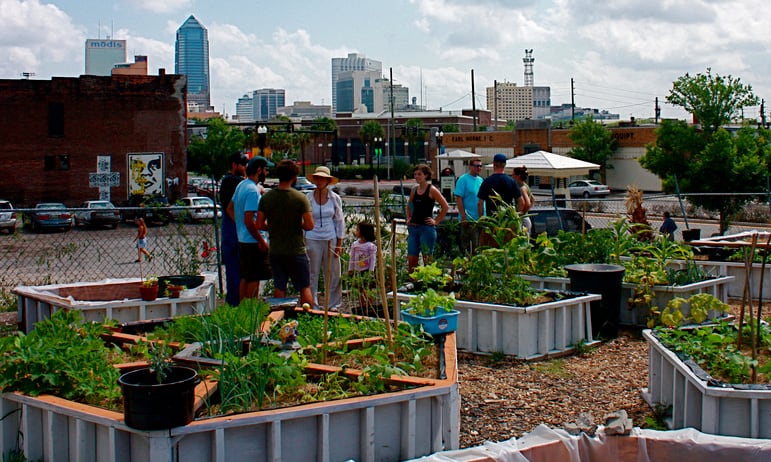City Blooming Fundamentals Explained
City Blooming Fundamentals Explained
Blog Article
The City Blooming PDFs
Table of ContentsExcitement About City BloomingThe Best Guide To City BloomingCity Blooming - An OverviewCity Blooming Can Be Fun For EveryoneThe Of City Blooming
Fascinated in growing food for sale in the City of Chicago? Below is a checklist of often asked inquiries pertaining to the guidelines and laws that cultivators need to think about when planning a city farming project.
The zoning amendment does not customize any type of other codes managing composting, building licenses, purchasing or leasing City had residential property, business licenses or environmental contamination. There are existing codes that control these concerns and they remain in full impact and might be relevant to your project. Neighborhood yards are commonly possessed or handled by public entities, civic organizations or community-based companies and maintained by volunteers.
Urban ranches grow food that is intended to be sold, either on a not-for-profit or for-profit basis. Due to their business purpose, metropolitan ranches need an organization license. Yes. A community yard is enabled to offer excess generate that was expanded on website if the sales are accessory or secondary to the yard's key objective described above.
Not known Details About City Blooming
The quantity of compost product can not surpass 25 cubic yards at any kind of offered time according to the requirements in 7-28-715 of the City's Municipal Code. Because the soil at most brand-new yard sites needs changing, garden compost, soil, timber chips, or other products can be acquired to build or boost the growing room.

If a structure permit is called for then the hoophouse will certainly be taken into consideration an accessory building. You can learn even more about the building authorization requirements by contacting the Division of Buildings. The 25,000-square-foot size restriction is meant to prevent a single neighborhood garden from dominating a provided block or detracting from the block's existing domestic or commercial character.
The restriction does not put on gardens situated in Public Open Space (POS) areas. Can there be greater than one area garden that is 25,000 square feet on a solitary block? Yes. The dimension limit puts on specific yards, not to private blocks. No. Fence is not needed, nonetheless, yards that have big parking lot may be needed to install secure fencing or other landscaping functions.
Not known Incorrect Statements About City Blooming
B1 & B2 areas require that all industrial use activities be performed indoors. R districts limit commercial task. The laws reflect the objective and intent of the Zoning Code. Is fence required for metropolitan ranches? Yes. Fences may be required, in addition to landscape design and testing, for particular parking lot and outdoor work or storage areas depending upon place and the details activity occurring.
Urban ranches need building licenses and zoning approvals prior to building (container and raised bed gardening etc.). Other forms of city testimonial other may be needed depending on specific frameworks, tasks, size, landscaping, licensing, public health and stormwater management issues.
Yes. The kind of permit is established by what is taking place at the website. The Department of Business Matters and Consumer Security can aid identify the certain type of business permit that's required. Yes. Off street car park is required for many industrial jobs in Chicago. The required number of garage is based upon the variety of staff members dealing with website and not the square video footage of the expanding room.
Excitement About City Blooming

A city ranch can market garden compost material produced on site, however, the procedure should conform with the policies in 7-28-715 of the Chicago Municipal Code. Aquaponic systems are permitted inside on metropolitan farms in several zoning areas.
As much as five hives or nests of honey bees may be maintained as an accessory usage. Nevertheless, beekeepers should register with the Illinois Division of Agriculture. For even more information about the suggested zoning amendment you may contact the Division of Housing and Economic Growth, Bureau of Planning and Zoning at 312.744.8563.
Farming in cities and urban locations An urban ranch in Chicago. Urban agriculture describes various techniques of cultivating. https://packersmovers.activeboard.com/t67151553/how-to-connect-canon-mg3620-printer-to-computer/?ts=1719460146&direction=prev&page=last#lastPostAnchor, processing, and distributing food in urban areas. The term also relates to the location tasks of pet husbandry, aquaculture, beekeeping, and gardening in a metropolitan context. Urban agriculture is identified from peri-urban agriculture, which happens in backwoods at the edge of residential areas.
City Blooming Can Be Fun For Anyone
It can involve an activity of organic cultivators, "foodies" and "locavores", who look for to develop socials media based on a shared values of nature and neighborhood holism. These networks can create using official institutional support, coming to be integrated into local community preparation as a "shift community" movement for lasting urban growth.
Some of the first evidence of city agriculture comes from Mesopotamia.
Report this page